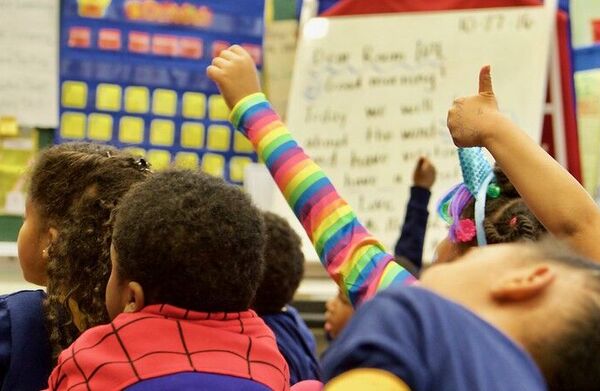Posted on
‘Shifting the lift:’ how one district is using cognitive science to transform teaching and learning
Category: Cognitive Science
In a rural school district in west Colorado, more than 300 teachers, mentors, and leaders are engaging in a district-wide, instruction-focused initiative that will strengthen their students' access to deep and rigorous learning experiences.
Six years ago, Delta County School District began embedding cognitive science into classroom teaching to better support student learning. They examined the research behind how our minds work, such as how we store and retrieve information from long-term memory, and began to enact district-wide learning on scientifically-informed teacher actions to ensure that all their students were not just engaged in content, but meaningfully understanding and building on their knowledge.

Photo of students with teacher, courtesy of Delta County School District

Today, this district-wide initiative has become a permanent fixture called the Science of Teaching and Learning, led by Shawna Angelo. And over the 2022-23 school year, the district partnered with DFI to dig deeper into a core component of cognitive science: effortful thinking.
Kurt Clay, Assistant Superintendent for Delta County School District, shared that by spring 2023, 100 percent of school leadership across the district raised their hand to continue the work.
“I’ve never had that with any other initiative in my 26 years of education,” reveals Clay. “For that to be the case, it’s a massive statement of our people’s belief in this work.”
Angelo and Clay shared insights on why this initiative got started and how it’s making a meaningful impact with teachers, leaders, and students across the district.
You shared that as of today, 100% of school leadership are onboard with this work – with 350 certified teachers, principals, and mentors increasingly bought into this work over the last year. That’s remarkable! But before we dig more into that, let’s back up a little. How did this work begin? And why does it matter?
Clay: We wanted a system that could better support our teachers to center student learning. All the research tells you that teachers make the difference, and we believe it. We started sending teachers to research conferences and began to establish a shared baseline understanding of what the research says, and how it supports kids to learn – how do we know they’re learning, and learn the right content.
Angelo: A core component of cognitive science is that the students have to be actively thinking. They have to have that information in their working memory and be actively processing it for it to be stored in long-term memory. And so we pulled out the strand of active thinking and really focused on that part and the terminology of what we called ‘shifting the lift’ – or what DFI calls ‘effortful thinking.’ How do we bring in more of the effortful thinking and scaffold that for students? How do we design our lessons so that they are engaged in that effortful thinking? We implemented some pilot initiatives to put the research into practice. And early successes from those efforts led us to district-wide initiatives.
Transitioning from those early pilot efforts to a district-wide initiative, especially with 350+ teachers and 4,700 students, seems like a pretty significant change effort, especially when it comes to asking more seasoned teachers to shift towards a different approach to teaching. How did you bring people along?
Clay: I look at districts as huge ships, you just don't turn them on a dime. You have to get everybody on board, so it was really critical that we established a foundation first. We haven't been just throwing darts randomly over the past five years – we were very intentional. We started to get our foundation with teachers at a level that we could speak the same language across the district, then explored grassroots ideas with people within school buildings. And so we had a pretty good basis of that happening in the classroom, but we didn't have everyone across having the same understanding for application. And so that's where we brought in DFI, to get implementation in the classroom and day-to-day lesson components, and meet all 300+ of our staff at that level.

Angelo walks through the learning engagements we led with leaders, mentors, and teachers.
Angelo discusses the aspects of our learning sessions that were especially valuable to teachers.
What were some of the highlights throughout the last year? How did you measure impact?
Clay: Jim [Heal, senior program director at DFI] taught it from a truly effortful thinking manner. So he modeled it exactly for our teachers of what we wanted them to do within the classroom as well as our principals. When people see it in action and understand the difference about why and how, and when we put effortful thinking in place and, and we even as adults are thinking from that aspect, it makes a huge impact on what we're trying to accomplish. So that is a critical component because the delivery is so, so important.
Angelo: For our teachers and leaders to dive deep into a 15-hour complex topic and to leave saying ‘I can do this’ is an incredible success. I had people coming up to me telling me it was the best training they’ve ever been to. That means a lot when some of them have 30 years in the classroom and administration.
Clay: Let me provide one example. We have a seasoned coach with a science background who was very lecture-driven and worksheet-oriented. And he's come up to me multiple times throughout the year and said, ‘I've been doing this all wrong.’ And his data is reflective of the change that he's made in the classroom. His kids are more engaged, because he feels better every day when he is in the classroom, because the conversations are richer. And kids are seeing the results, and he knows that they like science better because of his new method of teaching.
When we measure that, it's hard to put a number to it sometimes. But when that's the mentality of someone who’s taught for 30 years, it's huge when you can get someone like that to move because not only does he move, but he's making that same message very clear in his building, which is moving four, five, six, 10 other teachers at the same time. And so that's where the benefit is so big.
Angelo: We are seeing more and more stories like that. Just last week, a teacher that had spent five years in the classroom said, ‘I have been doing it wrong for the five years that I've been in the classroom.’ And I've heard people say, ‘I really wish I would've had this in my teaching. I wish I would've had this as day one of my teaching career, or I wish I would've had this in my teacher prep program.’

In our pre/post assessment with school leaders and mentors, we gave a question with six multiple choice responses that surveyed their understanding of and ability to apply effortful thinking principles in a lesson-based scenario. Two responses were correctly grounded in effortful thinking, and four were not. We provided this assessment at the start of our learning engagements and at the end and saw a significant increase in leaders and mentors choosing the correct responses, while also a meaningful decrease in them choosing the incorrect responses.
What’s next as you continue to build district-wide investment and learning?
Angelo: Continuing the progress towards bridging that gap between research and practice. I think people need manageable steps in order to do that. And I think having a framework and then actionable steps and, and the ability to see those steps for themselves and take that forward.
Clay: I agree, that's the big piece of how we push it forward in manageable components knowing that this work doesn't really stop. There's always gonna be a nuance and a new change that we need to get better at as we learn and, and research those things and new ideas and how do we continue that rolling with all of our teachers as our best learners.
We've now got these concepts, and we understand this is what effortful thinking is, and how it looks in the classroom, and this is how I know all my students are doing this Now, it’s, okay, when do I actually do it? How do I put it in my lesson? How do I get it embedded within my daily routine? And so now we're pushing forward on intentionally planning around effortful thinking. We’re focusing on success criteria, objectives, and the intentionality of not only what we’re teaching but how we’re putting it in our lessons to ensure the effortful thinking is taking place. A critical component is making the change stick.
Looking to implement something similar in your school district?
Fill out the form below, and we'll reach out to set up a call! We'd love to learn more about your district and explore how we can best support your instructional priorities.
Related Stories:

Blog
Diving deep into new concepts with effortful thinking
Effortful-thinking questions are like scuba diving gear for learners.
August 31, 2021
Blog
Novices and experts cannot think in the same ways
This post is the first in a periodic series exploring common misconceptions around how students...
January 29, 2016

Blog
Equipping new teachers with the skills to unlock deep and durable learning for every student
The 3rd cohort of the Learning by Scientific Design Network will focus on district-EPP partnerships.
April 25, 2024






